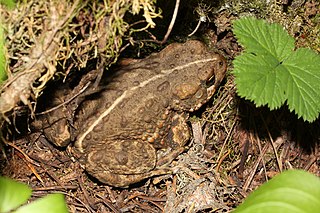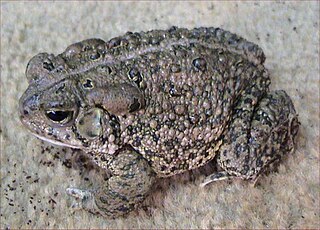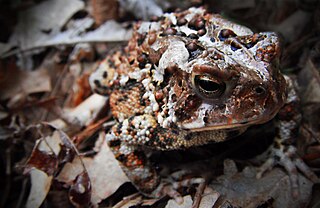
The black toad, also known as the Inyo toad or Deep Springs toad, is a true toad that lives only in scattered oases in the Deep Springs Valley of Inyo County, California. In fact, its original scientific name, Bufo exsul, means "exiled toad", which refers to its species' isolation in a tiny spot in the high desert wilderness of the Californian Great Basin.

The western toad is a large toad species, between 5.6 and 13 cm long, native to western North America. A. boreas is frequently encountered during the wet season on roads, or near water at other times. It can jump a considerable distance for a toad. Breeding occurs between March and July in mountainous areas, and as early as January in lower-elevation regions. The female lays up to 17,000 eggs stuck together in strings that adhere to vegetation and other objects along water edges.

The arroyo toad is a species of true toads in the family Bufonidae, endemic to California, U.S. and Baja California state, Mexico. It is currently classified as an Endangered species on the IUCN Red List of Threatened Species because of habitat destruction. The arroyo toad is at the intersection of ecological significance and conservation concern.

The red-spotted toad, formerly Bufo punctatus, is a toad in the family Bufonidae found in the southwestern United States and northwestern Mexico.

The northern sheep frog is native to Central America, Mexico, and extreme south Texas, United States. It occurs in the lowlands from Sonora, Mexico, to northern Costa Rica on the Pacific coast, and south Texas to Honduras on the Gulf of Mexico and Caribbean coasts. The sheep frog inhabits semiarid thornscrub, savannas, pasturelands, and open woodlands, as well as more humid, moist forest in the canyons, basins, foothills, and lower elevations of mountains slopes. It is a fossorial, burrowing frog that is seldom seen on the surface except at night after heavy rains when they emerge to breed. The sheep frog gets its name from its distinctive call that resembles a sheep's bleat. It is a diet specialist primarily feeding on termites and ants.

Woodhouse's toad is a medium-sized true toad native to the United States and Mexico. There are three recognized subspecies. A. woodhousii tends to hybridize with Anaxyrus americanus where their ranges overlap.

The boreal toad is the nominate subspecies of the western toad. They are commonly found in the western U.S. and western Canada. Boreal toad populations have declined recently due to an emerging amphibian disease, chytrid fungus. The boreal toad is currently listed as an endangered species by Colorado and New Mexico. It is known in Colorado as the only alpine species of toad.

Anaxyrus fowleri, Fowler's toad, is a species of toad in the family Bufonidae. The species is native to North America, where it occurs in much of the eastern United States and parts of adjacent Canada. It was previously considered a subspecies of Woodhouse's toad.

The Yosemite toad is a species of true toad in the family Bufonidae. Endemic to the Sierra Nevada of California, the species ranges from the Alpine County to Fresno County. Yosemite toads are only found in the montane to subalpine elevational zone of 1,950–3,445 m (6,398–11,302 ft) asl. The Yosemite toad is similar to the nearby western toad, but in many ways adapted to a high elevation lifestyle. It was initially described during the Grinnell Survey of California, by an undergraduate student of Joseph Grinnell named Charles Camp.

The oak toad is a species of toad in the family Bufonidae. It is endemic to the coastal regions of southeastern United States. It is regarded as the smallest species of toad in North America, with a length of 19 to 33 mm.
Wyoming is home to 12 amphibian species and 22 species of reptiles.

There are 14 species of amphibians and 5 species of reptiles known to occur in Mount Rainier National Park.

Robert Cyril Stebbins was an American herpetologist and illustrator known for his field guides and popular books as well as his studies of reptiles and amphibians. His Field Guide to Western Reptiles and Amphibians, first published in 1966, is still considered the definitive reference of its kind, owing to both the quality of the illustrations and the comprehensiveness of the text. A professor of zoology at the University of California, Berkeley, for over 30 years, he was the first curator of herpetology at the Museum of Vertebrate Zoology, a 1949 Guggenheim fellow, and author of over 70 scientific articles. His discovery of the ring species phenomenon in Ensatina salamanders is now a textbook example of speciation, and he performed extensive research on the parietal eye of reptiles. He produced nature films, supported science education in primary grades, and organized conservation efforts that aided in the passing of the 1994 California Desert Protection Act. After retirement he continued to paint, collect field notes, and write books. Stebbins is commemorated in the scientific names of three species: Batrachoseps stebbinsi, the Tehachapi slender salamander; Anniella stebbinsi, a legless lizard; and Ambystoma tigrinum stebbinsi, the endangered Sonora tiger salamander.
The Hot Creek toad is a species of toad in the family Bufonidae. It is endemic to Nye County in the state of Nevada in the United States.













